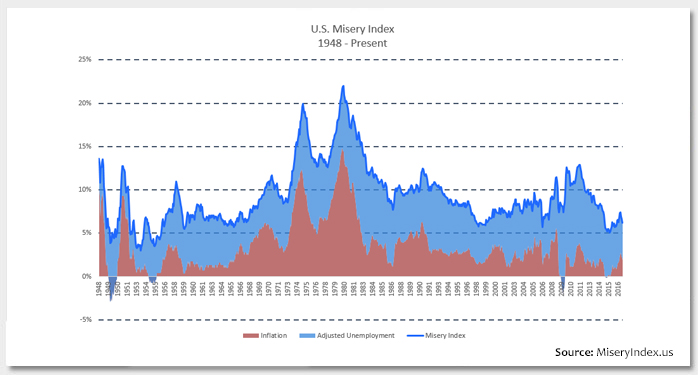The Misery Index, developed in the 1960s by Yale University economist Arthur Okun, has been a widely followed measure of national economic performance. The Index is calculated by simply adding together the trailing 12-month inflation rate and current unemployment rate. This week’s chart shows a nearly 70-year history of the Misery Index in the U.S.
The Misery Index rose in popularity (or maybe better stated unpopularity) during the Carter administration as stagflation reared its ugly head in the U.S. The Index peaked at nearly 22% in June 1980, as the annual inflation rate moved north of 14% and unemployment was 7.5%. The Index temporarily showed signs of life more recently following the financial crisis. A rapid doubling of the unemployment rate from 5% in April 2008 to 10% in October 2009 led the Index to move above 12% by the beginning of 2010.
However, the Misery Index has been in steady decline since 2010 as the unemployment rate has moved lower and inflation has consistently come in below the Federal Reserve’s (Fed) 2% target. The Index is now approaching its lowest reading in over 50 years as both inflation and unemployment appear headed lower for the second half of this year.
Key Takeaway:The current economic environment with both low unemployment and inflation flies in the face of one of the Federal Reserve's primary economic forecasting tools, the Philips Curve. The Philips Curve suggests wage inflation pressures (and inflation broadly) should pick up as the economy approaches full employment. Fed Chair Janet Yellen has stuck by Phillips Curve modeling but other Fed officials have started calling into question the relationship between low unemployment and higher inflation. St. Louis Federal Reserve President James Bullard recently suggested the Phillips Curve has never been a great forecasting tool. Will the Federal Open Market Committee (FOMC) tighten too rapidly for fear the Misery Index is just too good to be true? Or will the Fed be patient with additional rate hikes? I expect the Federal Reserve to shift away from rate hikes to a very gradual unwinding of its balance sheet and help sustain the trend toward less misery.
The material provided here is for informational use only. The views expressed are those of the author, and do not necessarily reflect the views of Penn Mutual Asset Management.
This material is for informational use only. The views expressed are those of the author, and do not necessarily reflect the views of Penn Mutual Asset Management. This material is not intended to be relied upon as a forecast, research or investment advice, and it is not a recommendation, offer or solicitation to buy or sell any securities or to adopt any investment strategy.
Opinions and statements of financial market trends that are based on current market conditions constitute judgment of the author and are subject to change without notice. The information and opinions contained in this material are derived from sources deemed to be reliable but should not be assumed to be accurate or complete. Statements that reflect projections or expectations of future financial or economic performance of the markets may be considered forward-looking statements. Actual results may differ significantly. Any forecasts contained in this material are based on various estimates and assumptions, and there can be no assurance that such estimates or assumptions will prove accurate.
Investing involves risk, including possible loss of principal. Past performance is no guarantee of future results. All information referenced in preparation of this material has been obtained from sources believed to be reliable, but accuracy and completeness are not guaranteed. There is no representation or warranty as to the accuracy of the information and Penn Mutual Asset Management shall have no liability for decisions based upon such information.
High-Yield bonds are subject to greater fluctuations in value and risk of loss of income and principal. Investing in higher yielding, lower rated corporate bonds have a greater risk of price fluctuations and loss of principal and income than U.S. Treasury bonds and bills. Government securities offer a higher degree of safety and are guaranteed as to the timely payment of principal and interest if held to maturity.
All trademarks are the property of their respective owners. This material may not be reproduced in whole or in part in any form, or referred to in any other publication, without express written permission.


